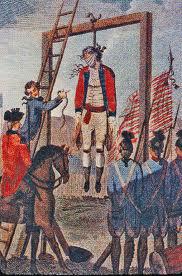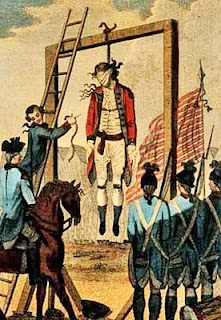The three illustrations below are of two executions that took place during the American War for Independence. The first two are said to record the execution of British Major John Andre, whom the Patriots hanged as a spy at Tappan, New York in October 1780. Andre was captured in civilian clothes after a secret meeting with Benedict Arnold, to arrange Arnold's switch to the British side.
Oddly, the Patriot officer presiding over Andre's hanging in the first illustration is in a redcoat. In the second, the mistake, if that's what it was, is rectified. He is wearing a blue coat, though a lighter blue than Patriot soldiers normally wore.


The last image is supposed to record the hanging of Colonel Isaac Hayne of South Carolina in Charleston in August 1781. British cavalry captured Hayne attempting to kidnap General Andrew Williamson, sometimes called the southern Benedict Arnold. Williamson was a Patriot officer who had also defected to the British (although later he claimed to have been spying on them). The charge against Hayne was treason. He had taken the loyalty oath to the Crown after Charleston's surrender in 1780 and later rejoined the Patriots.

The three illustrations are virtually identical, except for changes of uniform colors. Even the flags remain the same. It is likely that neither artist was present at either execution, but the artist of Hayne's hanging surely copied the artist of Andre's. Perhaps it was even the same artist.
Andre himself was a bit of an artist, and was good at working to a deadline (pun intended) The night before his execution he penned the self-portrait below.
London's V&A (Victoria and Albert) Museum in South Kensington is a treasure house of delightful curiosities. For me, none is more intriguing than a musical automaton depicting a "European" (actually a British soldier in The East India Company army) being mauled by a tiger.
Known as Tipu's Tiger, it was created for Tipu Sultan of Mysore (ruled 1782-1799).
Tipu adopted the tiger as his personal symbol. He used it on his soldiers' uniforms and weapons and on many objects in his palace and his capital, Seringatpatam. His personal epithet was "Tiger of Mysore." He said he would rather live two days as a tiger than a hundred years as a sheep.
Tipu spent much of his reign fending off attacks by the British East India Company, which sought to add his domain to its conquests on the subcontinent. He managed to prevail until 1799, when an East India Company army besieged and captured Seringatpatam. Tipu was killed defending his city.
The invading army divided up the plunder according to rank, as was the custom. Tipu's Tiger was sent to London as a curiosity. It was displayed at the Company's museum in Leadenhall Street for many years. It was acquired by the V&A in 1880. (Image: East India Co. Museum, Leadenhall Street. Tipu's Tiger can be see at far left).
Tipu's Tiger is a musical automaton. A hand-operated crank on the side of the tiger powers its movements and a bellows that produces sounds resembling a tiger's growl and the man's cries. The man's left arm moves up and down in a gesture of helplessness. A panel in the tiger's side conceals a small pipe organ on which tunes can be played. French advisers were present at Tipu's court at the time and may have aided in the automaton's construction.
V&A information on Tipu's Tiger: https://www.vam.ac.uk/articles/tipus-tiger









